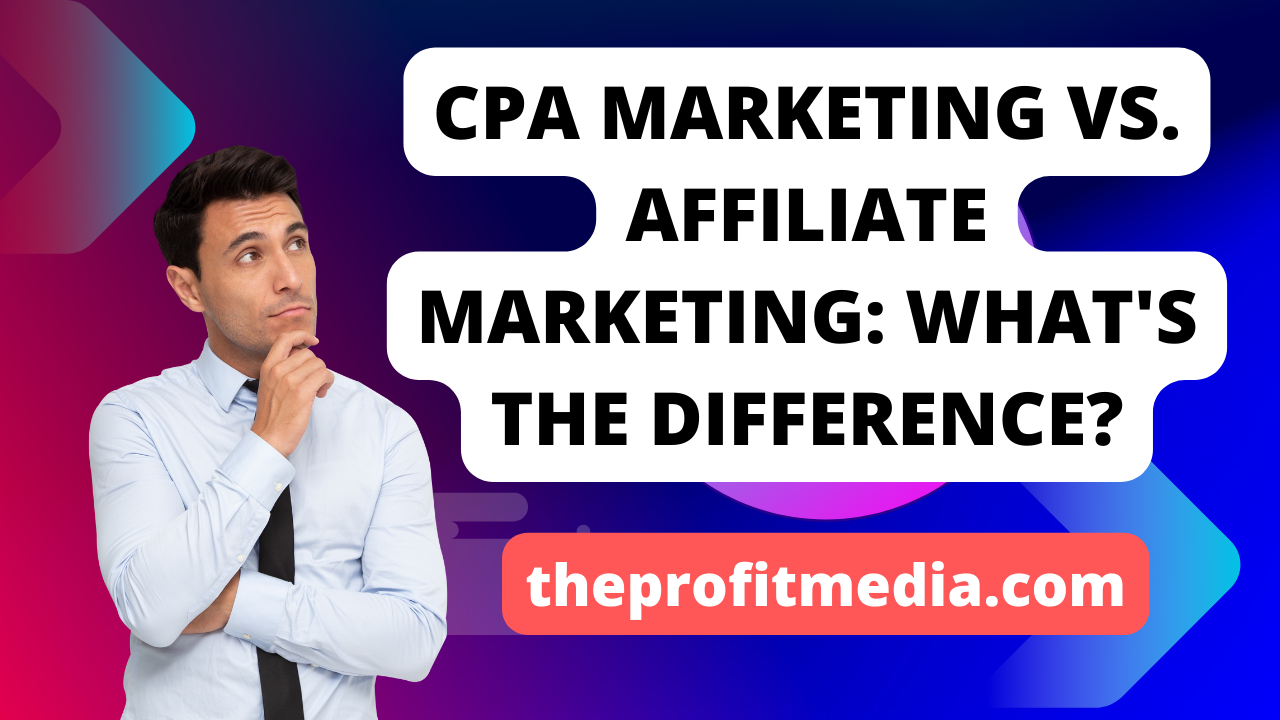CPA marketing and affiliate marketing are two popular ways to make money online. However, there are some key differences between the two.
CPA marketing stands for cost per action marketing. In CPA marketing, you are paid for each specific action that a user takes, such as signing up for a free trial, making a purchase, or filling out a survey.
Affiliate marketing, on the other hand, is a type of performance-based marketing where you are paid for promoting other people’s products or services. When someone clicks on your affiliate link and makes a purchase, you earn a commission.
Proven Way to Make Money Online – Watch this FREE Video to START >>

Here is a table that summarizes the key differences between CPA marketing and affiliate marketing:
| Characteristic | CPA Marketing | Affiliate Marketing |
| Payout model | Cost per action | Commission on sales |
| Action required | User takes a specific action (e.g., signing up for a free trial) | User makes a purchase |
| Network | CPA network | Affiliate network |
| Example | You promote a CPA offer where you are paid $1 for each person who signs up for a free trial of a software product. | You promote an affiliate offer where you earn a 10% commission on all sales of a product that you promote. |
In the world of digital marketing, CPA (Cost Per Action) marketing and affiliate marketing are two popular strategies used by businesses and individuals to generate revenue. While they share some similarities, they also have distinct differences. In this article, we will explore the key distinctions between CPA marketing and affiliate marketing, highlighting five points to help you understand each approach, and we will conclude by summarizing their unique strengths.
1. Payment Structure
One of the most significant differences between CPA marketing and affiliate marketing is the payment structure. In CPA marketing, advertisers pay for specific actions, such as a sale, lead, or download. Affiliates receive compensation only when the desired action is completed, ensuring that advertisers pay for actual results. In affiliate marketing, compensation is often based on a commission model, where affiliates earn a percentage of the sale or a fixed amount for each referral.
2. Level of Involvement
In CPA marketing, advertisers have a more hands-on approach, as they need to set up campaigns, create ad creatives, and choose the offers to promote. This approach requires a deep understanding of digital advertising and data analysis. In contrast, affiliate marketers focus on promoting existing products or services. They often have a pre-established audience, making it a more passive form of marketing.
3. Campaign Control
In CPA marketing, advertisers have a high level of control over their campaigns. They can choose the offers, ad creatives, and targeting options, allowing for precise optimization. In affiliate marketing, affiliates have less control over the products or services they promote, as these are determined by the merchant or product owner.
4. Risk and Reward
In CPA marketing, advertisers take on the majority of the financial risk. They pay for advertising and only profit if the desired actions are completed. In affiliate marketing, affiliates bear less risk, as they generally don’t invest in advertising costs. However, their earnings depend on their ability to drive conversions and generate sales.
5. Tracking and Reporting
CPA marketing typically involves more extensive tracking and reporting, as advertisers need to monitor campaign performance closely. They rely on data and analytics to optimize their campaigns continually. Affiliate marketing often involves tracking referrals and conversions, but the complexity is generally lower.
Proven Way to Make Money Online – Watch this FREE Video to START >>
1. Payment Structure
In the dynamic landscape of digital marketing, CPA (Cost Per Action) marketing and affiliate marketing are two strategies that often come into play, both designed to generate revenue. One of the key differences between these approaches is the payment structure, which significantly influences how marketers earn their income. In this article, we will delve into the distinction in payment structures between CPA marketing and affiliate marketing, elucidating how these models operate and what sets them apart.
CPA Marketing: Paying for Specific Actions
In CPA marketing, the payment structure is based on specific actions or conversions. Advertisers, seeking to promote their products or services, pay for a predetermined action to be taken by the audience. These actions can vary from making a purchase, filling out a form, subscribing to a newsletter, or downloading an app. Advertisers pay only when the desired action is successfully completed.
The payment for these actions is fixed and agreed upon before the campaign starts. This makes CPA marketing a performance-based model where advertisers take on the financial risk. They pay only when the desired actions are achieved, ensuring that their investment directly correlates with actual results.
Affiliate Marketing: Earning Commissions on Sales
In affiliate marketing, the payment structure is often based on commissions earned through successful sales or referrals. Affiliate marketers, also known as affiliates, promote products or services offered by a merchant or product owner. They earn a percentage of the sale or a fixed amount for each successful referral or conversion generated through their marketing efforts.
Affiliate marketers usually don’t have to invest in advertising costs, as their primary role is to drive traffic and convert it into sales. Their compensation is directly tied to their ability to generate sales or referrals, making it a commission-based model. The more sales or referrals an affiliate marketer generates, the more income they earn.
Key Differences
The key distinction in the payment structure between CPA marketing and affiliate marketing lies in where the financial risk is assumed. In CPA marketing, advertisers take on the primary financial risk, as they pay for advertising and only profit when the desired actions are completed. In contrast, in affiliate marketing, affiliates have a relatively lower financial risk, as they typically do not invest in advertising costs. However, their income depends on their ability to drive conversions and generate sales or referrals.
2. Level of Involvement
In the dynamic world of digital marketing, both CPA (Cost Per Action) marketing and affiliate marketing offer lucrative opportunities for individuals and businesses to generate revenue. One of the significant distinctions between these two approaches is the level of involvement required. In this article, we will explore the contrasting levels of involvement in CPA marketing and affiliate marketing, shedding light on the roles and responsibilities of marketers in each model.
CPA Marketing: A Hands-On Approach
CPA marketing typically requires a high level of involvement from advertisers or marketers. In this model, individuals or businesses set up and manage their advertising campaigns, including selecting CPA offers, creating ad creatives, and choosing their target audience. Advertisers take an active role in campaign optimization and fine-tuning to ensure their campaigns perform optimally.
Ad campaigns in CPA marketing demand careful planning and data-driven decision-making. Advertisers must closely monitor key performance metrics, such as conversion rates, click-through rates, and customer acquisition costs. They are responsible for making informed decisions based on these metrics and continually improving their campaigns to achieve the best results.
Affiliate Marketing: A More Passive Role
In contrast, affiliate marketing often involves a more passive role for marketers, known as affiliates. Affiliates typically focus on promoting existing products or services offered by merchants or product owners. Their primary responsibility lies in driving traffic and conversions through their marketing efforts.
Affiliates generally have less control over the products or services they promote. The merchant or product owner determines the offers, product details, and pricing. Affiliates use their marketing skills and pre-established audience to refer potential customers to the merchant’s website. Once a referral results in a sale or conversion, the affiliate earns a commission or fee.
Key Differences in Involvement
The primary difference in the level of involvement between CPA marketing and affiliate marketing is the degree of control over campaign elements. In CPA marketing, advertisers have a more hands-on approach, actively managing campaigns, selecting offers, and optimizing performance. They have greater control over the creative aspects of their marketing efforts.
On the other hand, affiliate marketers have a more passive role, with their primary focus on promoting existing products or services. They have limited control over the product details and pricing and often rely on the product owner to provide promotional materials.
Proven Way to Make Money Online – Watch this FREE Video to START >>
3. Campaign Control
CPA (Cost Per Action) marketing and affiliate marketing are two popular strategies in the digital marketing landscape, each offering unique approaches to revenue generation. Another significant difference between these two models lies in the degree of control marketers have over their advertising campaigns. In this article, we will explore the distinctions in campaign control between CPA marketing and affiliate marketing, shedding light on how marketers’ roles differ in each model.
CPA Marketing: Precise Campaign Control
In CPA marketing, advertisers enjoy a high level of control over their advertising campaigns. Advertisers, whether individuals or businesses, take the lead in planning, creating, and managing their campaigns. Here are some key aspects of campaign control in CPA marketing:
– Selecting CPA Offers: Advertisers choose from a wide range of CPA offers based on their goals, target audience, and niche. This selection process is crucial because it directly influences the success of the campaign.
– Ad Creatives: Advertisers have the creative freedom to design and craft ad creatives, including ad copy, visuals, and landing pages. This control allows for precise optimization to ensure that ads resonate with the target audience.
– Targeting Options: Advertisers can fine-tune their targeting options, selecting specific demographics, interests, and behaviors of their intended audience. This level of control ensures that the campaign reaches the right people.
– Campaign Optimization: Continuous monitoring and optimization are essential in CPA marketing. Advertisers closely watch campaign performance, track metrics like conversion rates, click-through rates, and customer acquisition costs, and make informed decisions to improve results.
Affiliate Marketing: Limited Campaign Control
In affiliate marketing, marketers known as affiliates often have less control over their advertising campaigns. Their primary role is to promote products or services offered by merchants or product owners. Key aspects of campaign control in affiliate marketing include:
– Product/Service Selection: Affiliates generally don’t have control over the products or services they promote. The merchant or product owner determines the offers, product details, and pricing. Affiliates must work with what is provided.
– Promotional Materials: Affiliates rely on the promotional materials provided by the merchant, which may include banners, text links, and other marketing assets. They use these materials to create content and attract potential customers.
– Traffic Generation: Affiliates focus on driving traffic to the merchant’s website through various marketing channels, such as content marketing, social media, or email marketing. Their control is limited to how they generate and direct this traffic.
– Conversion Tracking: Affiliates often rely on the merchant to provide conversion tracking tools and analytics. They use these tools to monitor the effectiveness of their promotional efforts.
Key Differences in Campaign Control
The primary difference in campaign control between CPA marketing and affiliate marketing is the level of creative and strategic freedom. In CPA marketing, advertisers have the creative autonomy to select offers, design ad creatives, and fine-tune targeting options. They actively manage and optimize campaigns to achieve the best results. In contrast, affiliate marketers work with existing products or services and promotional materials provided by the merchant, focusing their efforts on driving traffic and conversions.
Proven Way to Make Money Online – Watch this FREE Video to START >>
4. Risk and Reward
When it comes to digital marketing, the interplay between risk and reward is a crucial factor in determining the success and profitability of different marketing strategies. Both CPA (Cost Per Action) marketing and affiliate marketing offer opportunities for generating revenue, but they come with distinct approaches to risk and reward. In this article, we will explore the differences in the risk and reward dynamics between CPA marketing and affiliate marketing, shedding light on the financial aspects of these two strategies.
CPA Marketing: Balancing Risk and Reward
In CPA marketing, advertisers bear the primary financial risk associated with their advertising campaigns. The payment structure in CPA marketing is performance-based, meaning advertisers only pay when a specific action or conversion is completed. Here’s how risk and reward play out in CPA marketing:
– Risk: Advertisers invest in advertising, such as pay-per-click (PPC) ads or display ads, without any guarantee of immediate returns. They pay for ad spend and potentially generate no revenue if the desired actions are not completed by the audience. This risk makes CPA marketing suitable for those who are willing to invest in advertising and assume the financial risk associated with it.
– Reward: The reward in CPA marketing is clear and direct. Advertisers only pay when the desired action, whether it’s a sale, lead, or download, is successfully completed. This payment structure ensures that the financial risk is balanced by a clear and direct reward, making it a performance-based model.
Affiliate Marketing: A Different Risk and Reward Model
Affiliate marketing often offers a different risk and reward model compared to CPA marketing. In affiliate marketing, marketers known as affiliates promote products or services offered by merchants or product owners. Here’s how risk and reward operate in affiliate marketing:
– Risk: Affiliates typically have a lower financial risk compared to advertisers in CPA marketing. They often do not invest in advertising costs. Their primary risk is the time and effort spent on promotional activities. If the affiliate marketing campaign does not generate sales or referrals, affiliates may not earn any commissions, but they do not have to cover ad expenses.
– Reward: Affiliates earn a commission or fee for each successful sale or referral they generate. The reward is tied to their ability to drive conversions and generate revenue for the merchant or product owner. Successful affiliate marketers can earn a substantial income, and the reward is directly related to their efforts.
Key Differences in Risk and Reward
The key differences in risk and reward between CPA marketing and affiliate marketing lie in the financial risk assumed and the compensation structure:
– In CPA marketing, advertisers assume the primary financial risk by paying for advertising with no guarantee of immediate returns. The reward is a direct result of successful actions or conversions.
– In affiliate marketing, affiliates have a lower financial risk, as they often do not invest in advertising costs. The reward is based on the commissions earned for driving sales or referrals.
5. Tracking and Reporting
Effective tracking and reporting are essential components of any successful digital marketing strategy. Both CPA (Cost Per Action) marketing and affiliate marketing rely on robust data analysis to gauge performance, optimize campaigns, and make informed decisions. In this article, we will explore the differences in tracking and reporting between CPA marketing and affiliate marketing, shedding light on how these models handle data and analytics.
CPA Marketing: Data-Driven Optimization
In CPA marketing, data-driven optimization is a fundamental practice. Advertisers place great emphasis on tracking and reporting to ensure their campaigns perform optimally. Here’s how tracking and reporting operate in CPA marketing:
– Performance Metrics: Advertisers closely monitor key performance metrics, such as conversion rates, click-through rates, customer acquisition costs, and return on investment (ROI). These metrics provide valuable insights into the effectiveness of their campaigns.
– Data Analysis: Data analysis is integral to CPA marketing. Advertisers use analytics tools to dissect the performance data, identifying strengths and weaknesses in their campaigns. They rely on data to make informed decisions and continually optimize their strategies.
– A/B Testing: A/B testing is a common practice in CPA marketing. Advertisers conduct experiments by comparing different ad creatives, landing pages, and targeting options to determine what works best. This iterative approach ensures campaigns evolve and improve over time.
– Budget Allocation: Data and analytics play a crucial role in budget allocation. Advertisers use performance data to determine which campaigns and channels are most effective, allowing them to allocate resources efficiently for maximum ROI.
Affiliate Marketing: Tracking Referrals and Conversions
In affiliate marketing, tracking and reporting revolve around tracking referrals and conversions. Affiliates rely on the data provided by the merchant or product owner to monitor their efforts. Here’s how tracking and reporting work in affiliate marketing:
– Referral Tracking: Affiliates use tracking links or unique identifiers provided by the merchant to track referrals. These links allow affiliates to monitor the traffic they send to the merchant’s website.
– Conversion Tracking: Affiliates depend on the merchant’s conversion tracking tools to determine when a referral results in a sale or conversion. This data is crucial in calculating the affiliate’s earnings.
– Performance Reports: Merchants or product owners typically provide affiliates with performance reports, detailing the number of referrals, conversions, and earnings. Affiliates use these reports to gauge the effectiveness of their promotional efforts.
– Commission Payouts: Commission payouts are directly tied to the tracking and reporting provided by the merchant. Accurate tracking and reporting ensure affiliates are compensated fairly for their efforts.
Key Differences in Tracking and Reporting
The primary differences in tracking and reporting between CPA marketing and affiliate marketing are in the nature of the data and the control over the tracking process:
– In CPA marketing, advertisers have full control over tracking and reporting, using data analytics to optimize their campaigns continually.
– In affiliate marketing, affiliates rely on tracking and reporting provided by the merchant. The focus is on tracking referrals and conversions to calculate earnings.
Proven Way to Make Money Online – Watch this FREE Video to START >>
Conclusion
CPA marketing and affiliate marketing are two distinct approaches to generating revenue in the digital realm. While both share similarities in that they are performance-based, the differences are significant. CPA marketing offers more control and a direct approach with advertisers paying for specific actions. Affiliate marketing is generally more hands-off for affiliates, who promote existing products or services with a commission-based compensation structure.
Ultimately, the choice between CPA marketing and affiliate marketing depends on your expertise, resources, and level of involvement. Both strategies can be lucrative when executed effectively, so it’s essential to understand their nuances and select the one that aligns best with your goals and capabilities.











